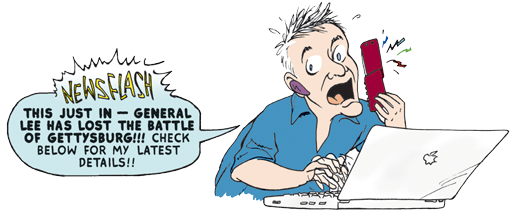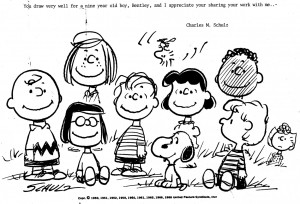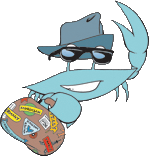

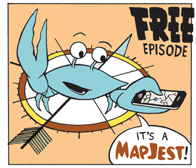

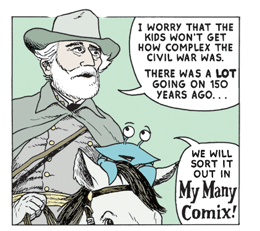
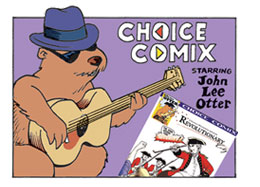
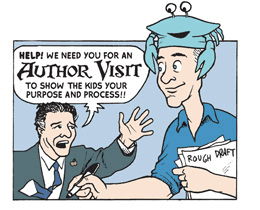

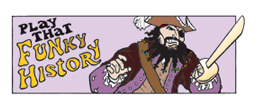

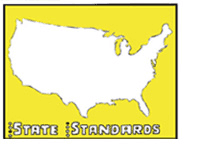


|
|

|
 |
||
 |
"Thank you so much for making a comic that children WANT to read and learn from." Niesa Wilhelm, 2nd grade teacher in Virginia |
|
|
|
||
Posts Tagged ‘Chester the Crab’
I Dream of Sparky
Written on Saturday, November 28th, 2009 [permanent link]I’ve been blessed to meet most of my cartooning heroes in the past 20 years, but I never got to meet Charles “Sparky” Schulz.
Until two nights ago. I had a dream that I found him — he was undercover, hiding from his worldwide fame as the creator of “Peanuts.” He was a schoolbus driver for elementary kids! Somehow I had reason to get on his bus (though my two sons are well out of elementary school now, I may have been there mentally because that’s still my target audience for my comix) and I easily recognized him under his old guy felt cap. He looked like a kindly grandpa and was very quiet — even as he asked me to not reveal his secret. Of course I promised I would not.
It was a great dream. It made me very happy to make that simple connection, standing on the steps of that bus. The day outside the bus was sunny and warm — were we in California, where Schulz the Quiet Minnesotan had found a place to draw his magic? Or had he moved to my town, Williamsburg, like so many other retirees? My dreams are always based in reality — I’m never flying, never shooting through space talking to aliens. I’m chatting with Charlie Brown’s dad!!
A 42-year-old cartoonist dreaming about Charles Schulz is nothing remarkable — my generation of cartoonists grew up chasing his example. I and many of my peers started drawing by copying the Charlie Brown and Snoopy strips we read in the newspaper. I recreated a bunch of them line-for-line and mailed them to Schulz, and some nice secretary mailed me back the form letter you see above. And it was one of the best moments of my life.
Thank goodness Sparky paid for that secretary to crank out those form letters. That simple piece of paper inspired me to keep going, to keep practicing, to believe that my dream of finding a job as a cartoonist could be real. I’ve had plenty of inspirations from many sources to be an Artist, but Schulz was the shining example that you could get a JOB as a CARTOONIST and maybe conquer the world.
And here he was in my dream, giving up the world to live a simple life caretaking children. Which is what he had already done for decades with his cartooning.
From one of those kids, Thanks, Sparky!
Tags: Bentley Boyd, cartooning, Charles Schulz, Charlie Brown, Chester Comix, Chester the Crab, elementary school, Peanuts, Snoopy
Posted in Author's Purpose | No Comments »
OK, Twitter too!
Written on Saturday, November 21st, 2009 [permanent link]Woah, there are a lot of librarians on Twitter!!! And plenty of other cool people, too. So now ChesterComix will be a Tweet you can follow as I hack my way through history.
I remember hearing about Twitter for the first time on an NPR talkshow in 2007. The host kept reading sample Tweets and then asking the founder, “But WHY do I care that Jamie just ate a taco?!?!” I asked the same question. I love Facebook so much that I thought it and this public website blog would keep my update bases covered. Who would care if I ate a taco?!?!
But Twitter is really connecting a lot of interesting people. And it seems a great Do-It-Yourself way to send a short press release. And my business is all about Do-It-Yourself tech. So I’ve added my voice to one of the most insistent pieces of the Web 2.0 cloud of information.
I hope it’s not too boring for you to hear about when I’m researching just how to draw an 1890s farmhouse in Idaho . . .
Check it out: http://twitter.com/ChesterComix
Tags: Bentley Boyd, Chester Comix, Chester the Crab, educational comics, graphic novels, history comics, Twitter
Posted in Author's Purpose | No Comments »
Comics boost literacy (like any children's picture book does!)
Written on Sunday, November 15th, 2009 [permanent link]The www.sciencedaily.com web site recently had a good overview of comix-and-literacy by Carol L. Tilley, a professor of library and information science at Illinois. Her analysis matches the points I try to get across to teachers and librarians and parents: that comics are just as sophisticated as other forms of literature, and children benefit from reading them at least as much as they do from reading other types of books.
If reading Dr. Seuss to kids at age 5 is good, then it’s good for that same kid to read Spider-Man at age 10. Comix shouldn’t be the only thing kids read, but if it’s the favorite form of reading for a child who would otherwise be playing a video game or watching TV, then let’s keep comix near him!
Why do we assume that reading a chapter book with no pictures is the highest form of literacy? A book without visual images does not look like the world I live in — a novel is actually an artificial construction, cutting off most of the information we use to navigate the real world (visuals, sound, interplay in conversation . . . ). In their own way, novels-without-pictures are as much an artificial environment as any video game — and can be as fun and as worthwhile to dive into as any video game, but why do we as a culture continue to assume that novels are superior to other forms of media?
Soon, articles like the one I’m linking to won’t appear because the category lines in children’s literature will have blurred so much. I try to blur that line in my author’s talks to students and in my teacher in-service training programs. I ask people to compare the page layout of a children’s book with pages from comix, and, like Tilley here, we can see the distinct comic book tools — frames, thought and speech bubbles, motion lines — being co-opted by children’s books, creating a hybrid format.
Here’s the whole article:
www.sciencedaily.com/releases/2009/11/091105121220.htm
Tags: Bentley Boyd, Chester Comix, Chester the Crab, comic book, literacy
Posted in literacy | No Comments »

